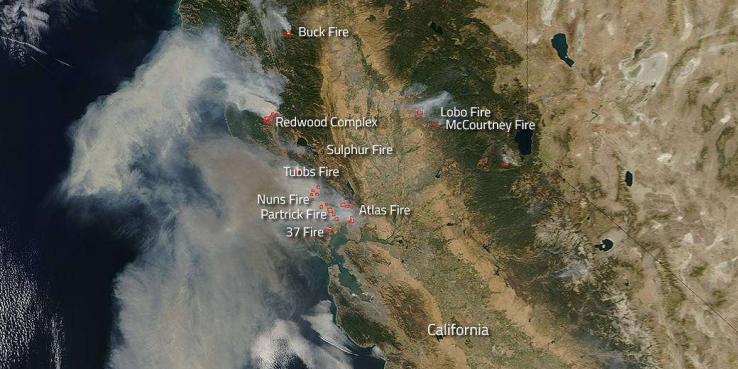The Bay Area’s hazardous landscape is in the public eye again. The Kincade Fire — presently only 15% contained — has forced the largest-ever evacuation of Sonoma County and threatens areas that are still recovering from the devastating fires of 2017. This and other fires are sending plumes of smoky, hazardous air around the Bay. Public safety power shutoffs have impacted over one million people in Northern California. And just last month, two small, widely felt earthquakes — plus the 30th anniversary of the deadly and damaging Loma Prieta quake — reminded us of our vulnerability to earthquakes.
What’s going on? We all know that the Bay Area is exposed to natural and human-driven hazards: flooding, wildfire, earthquakes, tsunamis, landslides, extreme heat, sea level rise. But as the climate changes, some of these are becoming more frequent, more severe and longer in duration. Wildfire frequency is expected to increase between 25% and 50% by the end of the century, with a greater likelihood of large fires. Sea level rise threatens our long coastline with permanent flooding. Other threats are not new — and are not going away. The “Big One,” an earthquake with a magnitude of at least 7.0, has a high likelihood of happening in our lifetimes.
Some of these threats are worse today because of decisions we made in the past. Permissive zoning laws have allowed sprawl development into the region’s forested areas, which are prone to wildfire and tend to have few evacuation routes. Cities once used San Francisco Bay as a landfill. Now, many areas built on low-lying land near the Bay shore are just a few feet above high tide, where they are vulnerable to sea level rise, sunny-day flooding and liquefaction caused by earthquakes. Our water and power infrastructure is aging and brittle. And of course, global climate change — a force multiplier — is a human-driven crisis that worsens every day with inaction. Our collective inability, or unwillingness, to reduce emissions will continue to worsen these hazards, and thus the risks of living in the Bay Area.
There are certain hazards we cannot prevent — but that doesn’t mean we have to accept worsening damages and deaths as the price of living here. We can do something about this — and we can correct mistakes made in the past. It is the job of government to protect people as much as science and our toolbox — things like land use planning, building codes and emergency response — allows. Climate adaptation will not come cheaply or easily, but inaction will be far more costly. Disaster recovery is more expensive than investing in prevention and mitigation.
What are some of the solutions? For one, cities and counties should stop allowing new development to encroach into areas of very high wildfire risk, or in areas of recurrent or worsening flooding. Instead, we should focus on building infill development in existing urbanized areas to help address our housing crisis and place these much-needed new homes in safer locations. Second, the state should adopt a more resilient building code and require older buildings to be retrofitted according to the hazards they are vulnerable to, whether that means bracing and bolting for earthquake safety, hardening roofs and landscapes for fire resilience or floodproofing basements and ground floors. Third, we need to make coordinated investments in the safety of our lifeline infrastructure: water, sewer, electricity, broadband and more. This infrastructure is interdependent, it is essential for our economy, our health and our safety, and it will be critical to facilitate disaster recovery. The longer it takes to recover from a disaster like a major earthquake, the greater the risk of permanent displacement of thousands of people and jobs from the Bay Area.
Public safety power shutoffs are an example of a stop-gap measure that do not secure any future resilience. Such band-aids are also deeply unpopular. We know that communication and warnings can be much better, and that there is a role for public oversight of the frequency, duration and extent of these shutoffs. But we can all agree that catastrophic wildfires, deaths, damaged homes and hazardous, smoky air lingering for days are far worse. What could we invest in today that would allow us not to have to choose between two terrible options? That is the challenge of building resilience for natural hazards and climate change, and it is what the Bay Area must work on immediately.
We must also recognize our interdependency here in the Bay Area. One community’s actions to increase resilience — or its failure to act — affect its neighbors and the region as a whole. What one forested community chooses to do about fires affects the safety of all adjacent communities. What one city chooses to do about earthquake-vulnerable buildings affects surrounding cities and the economy. What one shoreline community chooses to do to manage sea level rise can affect flooding for its neighbors. If we don’t plan regionally, the resilience investments we do make may not have the expected payoff or safety benefits.
There will always be hazards we can’t control, but there are ways we can react to them and plan for the next time to be calmer, safer and less disruptive. Public safety power shutoffs, and their failure to prevent wildfires this month, are a wakeup call that we must work together to identify all the vulnerabilities of our built environment, plan ahead and not force the Bay Area’s future into a series of choices between bad options.
